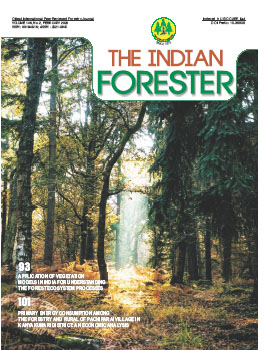Fibre Dimorphism in Secondary Xyiem of Family Lauraceae from Erstwhile India
DOI:
https://doi.org/10.36808/if/2020/v146i2/128194Keywords:
Lauraceae, Wood Fibres, Parenchyma-Like-fibres, Fibre Dimorphism, Storage Fibres.Abstract
Secondary xylem of Forty seven species of family Lauraceae was studied for fibre dimorphism (i.e. species having both Fibres and Parenchyma-like-Fibres). These species fail under eleven genera viz. Actinodaphne, Aiseodaphne, Beiischmiedia, Cinnamomum, Cryptocarya, Dehaasia, Lindera, Litsea, Neoiitsea, Persea and Phoebe. Parenchyma-like-Fibres (PLF) were found to be present in 90% of the species of this family and have not been reported earlier. PLF were observed both in wood section and maceration. The PLF was found to be species specific. However, within a species variation with regards to amount ofPLF was observed based on which 12 categories were made. The septation in PLF was observed to be independent of fibre septation. PLF were not observed in 5 species viz. Actinodaphne tedulingami, Aiseodaphne semicarpifolia, B. fagifolia, Cinnamomum glanduliferum and C. zeylanicum. Statistical analysis inferred that the volume of fibre and volume of PLF showed significant linear correlation relationship which indicates that PLF are basically storage fibres with more lumen and lesser wall thickness and length.References
Baas P., Zweypfenning R.C.V.J. (1979). Wood Anatomy of the Lythraceae. Acta Bot. Neerl. 28:117-155.
Bonsen K.J., Ter Welle BJH (1984). Systematic wood anatomy and affinities of the Urticaceae. Bot. Jahrb. Syst. 105:49-71.
Bor N.L. (1953). Manual oflndian ForestBotany. Bombay.
Carlquist S. (1957). Wood Anatomy of Mutisieae (Compositae). Trop.Woods, 106:29-45.
Carlquist S. (1958). Wood Anatomy of Heliantheae (Compositae). Trop.Woods, 111:19-39.
Carlquist S. (1987). Wood Anatomy of Martyniaceae and Pedaliaceae. Aliso, 11:463-471.
CarlquistS. (1988). Comparative Wood Anatomy. SpringerVerlag.
Heimsch C. (1942). Comparative anatomy ofthe secondary xylem of the 'Gruinales' ofWettstein with reference to taxonomic groupings. Lilloa, 8:83-198
IAWA Committee (1989). IAWA list of microscopic features for hardwoods identification. IAWA. Bull. n.s. 10: 219-332.
Hess R.W. (1946). Keys to American woods. XIX. Special fibres in Parenchyma-like arrangement. Trop. Woods, 85:15-16.
Klaassen R., Bass P. (1999). Woodanatomyofthe Sapindaceae. IAWA, Netherlands.
Metcalfe C.R., Chalk L. (1950). Anatomy ofthe Dicotyledons, Vol. II. Clarendon Press, Oxford.
Nair M.N.B., Mohan Ram H.Y. (1992). StructureofSola wood: the traditional art material. Current Science, 62(11) Pearson R.S., Brown H.P. (1932). Commercial Timbers of India, Vol. II. Calcutta, 1932.
Purkayastha S.K. (1985). Indian Woods- their identification, properties and uses. Vol. V. Controllerof Publication, Delhi.
Record S.J. (1944a). Keys to American woods. XIII. Woods with septate fibres. Trop. Woods. 78:33-45.
Record S.J. (1944b). Keys to American woods. XV. Fibres with conspicuous bordered pits. Trop. Woods, 80:11-13.
Vliet G.J.C.M.Van (1981). Wood Anatomy of the palaeotropical Melastomaceae. Blumea, 27:395-462.
Wheeler E.A., Simpson T.D., Rogers S.L., Gasson P.E., Brown K.R., Bartlett J.R., Baas P. (2004- onwards). Inside wood: a new internet-accessible wood anatomy database. Published on the Internet. http://insidewood/lib.ncsu.edu/search.
Downloads
Downloads
Published
How to Cite
Issue
Section
License
Unless otherwise stated, copyright or similar rights in all materials presented on the site, including graphical images, are owned by Indian Forester.





